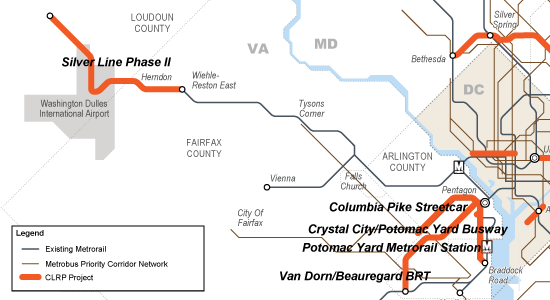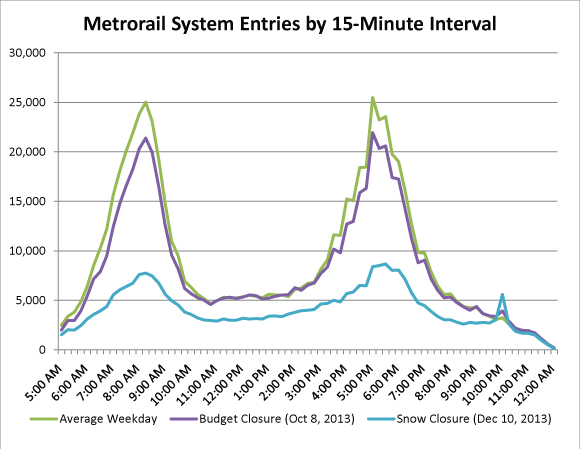Adding two extra cars to a six-car Metrorail train might not seem like much, but it is equivalent to widening I-66 through Arlington by two lanes. Plus, it’d likely be cheaper and faster for commuters, too.
Sometimes it’s hard to wrap one’s head around how just many people Metrorail can move. But where Metrorail operates in heavily congested corridors, seemingly small improvements can yield big results. In fact, matching the capacity of all eight-car trains system-wide would require 16-18 lanes of freeway into downtown, each way.

To match the capacity of eight-car trains on Metro, we’d have to widen I-66 in Arlington by at least two lanes. (Photo by wfyurasko, click for original)
In Arlington for instance, going to eight-car trains on the Orange Line as part of Metro 2025 is like widening I-66 by two lanes. Let’s do the math:
- One lane of highway can move around 2,200 cars per hour, at its theoretical maximum.
- Today, every morning Metrorail runs about 18 trains per hour eastbound on the Orange Line through Arlington, and about a third are scheduled eight-car trains. That’s a train every three minutes, and equates to around 121 rail cars per hour, or 12,060 passengers per hour.
- By 2025 with eight-car trains, Metrorail will be able to run 21, eight-car trains per hour eastbound on the combined Orange and Silver Lines, which equates to 168 cars per hour.
- This means Metro 2025 will bring the line’s capacity to 16,800 riders per hour, or an increase of 4,740 passengers per hour.
- To accommodate 4,740 more people on I-66 at 2,200 cars per hour, 2 people per car, we’d need 4,740 / 2 / 2,200 = 1.1 highway lanes in each direction.
That means we’d need at least two new lanes on I-66 to match the capacity of Metro 2025. In addition, eight-car trains would be cheaper, and would likely move people faster through the corridor.
- Eight-car trains on Metro would be over two times cheaper: the estimated cost to widen I-66 works out to about $3.50 per rush-hour trip over the life of the project, whereas Metro 2025 would be about $1.50.
- Metrorail would likely move travelers faster than I-66 in the end. Orange Line trains today normally run at around 35 miles per hour, while congested travel speeds on I-66 average around 18 miles per hour. While new highway lanes might move cars faster at first, the improvements would eventually be eroded by growing congestion.
Metro 2025 would bring significant benefits to northern Virginia, allowing the region to thrive economically while preserving regional vitality.
Think Metro’s Momentum plan is all about “downtown?” Think again! Our seven Metro 2025 initiatives – from eight-car trains to bus-only lanes will bring dramatic improvements to the quality of life and transportation to northern Virginia.

Supports Virginia Transit Projects
Virginia is planning big for transit, which is great – but all of the planned projects rely on a robust Metrorail and Metrobus “backbone” to succeed:
- The Silver Line extends Metrorail by over 20 miles, and will generate tens of thousands of new riders per day when Phase II opens – many of whom will travel into Metrorail’s already congested core.
- The Columbia Pike Streetcar will transfer 32,000 riders per day to and from Metrorail at Pentagon City – at a point in the system that is already maxxed out.
- Two other planned busways (Crystal City/Potomac Yard, and Van Dorn/Beauregard) also connect with Metrorail stations.

All major transit projects funded in the CLRP in Northern Virginia depend on the “backbone” of Metrorail and Metrobus.
By ensuring that Metro services can keep pace with congestion and demand, Metro 2025 is critical to making Virginia’s transit projects a success, and critical to helping the region and the state reach its transportation goals. Read more…
When it comes to impacting weekday Metro ridership, meteorologists are three times more powerful than the federal government.
Many factors influence Metrorail ridership, including the weather and the status of the federal government. As this assessment shows, extreme weather has a much bigger impact on Metrorail usage than the federal government closure for budget reasons.
In the past few months, the federal workforce was instructed to stay home for two different reasons. The first was the failed budget negotiation that resulted in the federal government shutdown in October of 2013. (We’ll call this “shutdown closure.”) The second was the winter weather forecast that closed federal offices in the Washington region. (Let’s call this “snow closure.”) These two separate government closures have had different impacts on Metrorail ridership.
First, take ridership by time of day. The graph below shows ridership by fifteen-minute interval for three days. The tallest, green line is the average of weekday entries. The other two are days that the federal government was closed due to the shutdown (Oct 8, 2013) and snow (Dec 10, 2013). Now, the purple line illustrates the ridership due to the budgetary shutdown in October 2013 and the blue line shows ridership on a federal snow day in December 2013. The purple line (budget shutdown) is not dissimilar to the green (average), but the purple line (snow shutdown) illustrates a huge ridership drop. Why would this be?

Metrorail ridership on an average day and two days the federal government was shut down. October 8, 2013 was part of the budget shutdown. December 10 2013 the fed was closed due to snow.
We can think of a few reasons for this difference.
- The budget shutdown only impacted SOME federal workers, i.e. those not deemed essential. Snow, however, impacts just about everyone.
- On snow days, area schools are often closed. Parents who have the luxury to do so sometimes stay home to look after their children who would otherwise be in school. Critically, parents who may be limited in child care options – many of whom are our customers – are especially vulnerable and often are forced to stay home because of the school closures.
- Washington is gradually evolving from a federal “company town” into a “boom town of the new economy,” a new economy less reliant on the federal government. Many of the businesses of the “new economy” were unaffected by the budget shutdown, but during extreme weather events take their cue from the federal government and give their employees the day off. According to Dr. Stephen Fuller of GMU’s Center for Regional Analysis, the Washington region is and will be “increasingly less dependent on federal spending as the driver of job growth and income generation in the local economy.”
Next, let’s look at change in ridership by station. Below are maps showing the change in ridership between a regular day and one of the government shutdown days: first budget shutdown and then snow shutdown. Read more…





Recent Comments